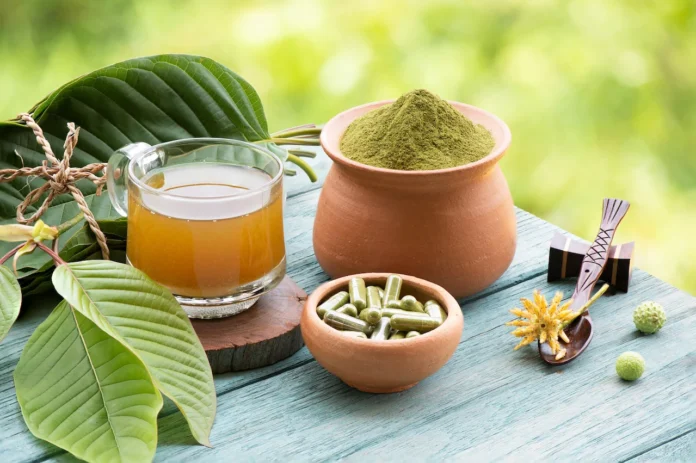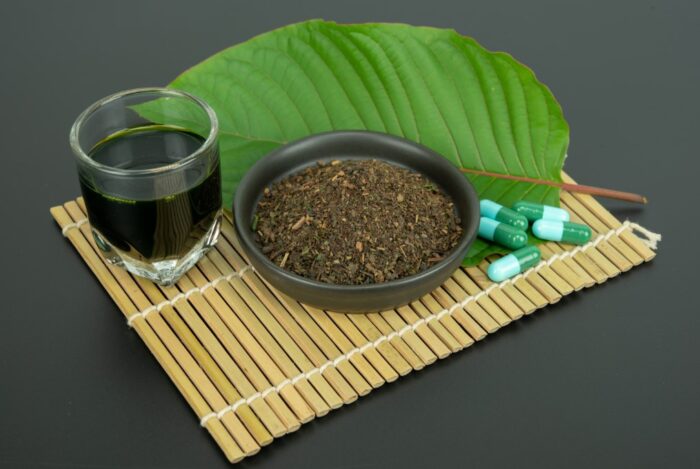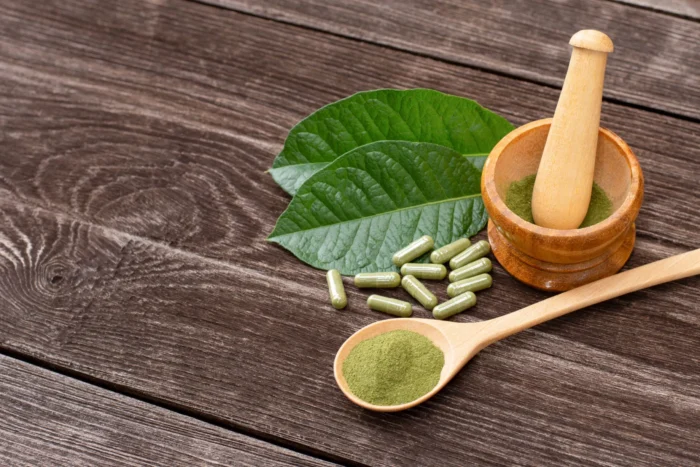
Kratom, or Mitragyna speciosa, is a tropical evergreen tree that can reach heights of up to 25 meters and has become an increasingly popular natural herbal remedy. In recent years, its therapeutic potential has made headlines as many users report positive impacts on their chronic pain, anxiety levels, and even opioid withdrawal symptoms.
However, despite its well-known health benefits, there are still some reservations about kratom, as experts debate the risks associated with taking it without proper medical guidance.
Therefore in this article, we will delve deeper into what kratom is and explore the reported benefits and any potential side effects so that readers can make informed decisions about whether or not this natural herb may suit them.
Understanding Kratom

Kratom is a tropical tree native to Southeast Asia, with leaves used for medicinal and recreational purposes for centuries. While its chemical composition is complex, the active ingredients in kratom are mitragynine and 7-hydroxy mitragynine, which interact with the body’s opioid receptors, producing effects similar to opiates but with different side effects and withdrawal symptoms.
Kratom can be consumed in various forms, including capsules, tea, or leaf chewing directly. While it is still legal in some countries, its legal status changes quickly due to concerns over its safety and potential for abuse. Understanding kratom’s effects and potential risks is vital for anyone considering it. Crushed leaf kratom can be made into a powder and taken as a tea or capsule.
Exploring the Benefits of Kratom
Kratom has become increasingly popular due to its reported potential therapeutic benefits across multiple areas. Many users report positive experiences with kratom, citing improvements in their pain, stress, sleep quality, and a decrease in levels.
Pain relief is often cited as the primary benefit of taking kratom. The alkaloids in kratom interact with opioid receptors in the body, providing analgesic effects that can be used to treat chronic and acute pain conditions such as arthritis or fibromyalgia. Kratom can also be used to manage symptoms caused by cancer treatment.
Users also report improved sleep quality after using kratom, as it is thought to increase serotonin production, which can help induce relaxation and improve overall sleep quality. Additionally, kratom reduces stress levels and promotes a sense of well-being.
Potential Risks of Taking Kratom

Kratom is not regulated in the United States, meaning there is no way for users to know exactly what they are ingesting. Additionally, it may interact with certain medications and can cause adverse reactions. Common side effects include nausea, vomiting, and constipation. It can also raise heart rate and blood pressure and cause confusion and hallucinations at high doses.
When taken in excess or over an extended period, kratom carries a risk of addiction similar to opioids. As a result, many countries have banned its sale or restricted its use due to concerns about abuse potential. Users should be aware of these risks when taking kratom and discuss their options with a doctor before proceeding.
How to Safely Use Kratom
It is important to note that there is no one-size-fits-all approach to kratom use, as the effects will vary from person to person. Generally, starting with a low dose of around 2–3 grams is best and increasing gradually over time until the desired effects are achieved.
It is also crucial for users to be aware of their reaction times when taking kratom and adjust accordingly. Some people may find that they need more or less than the recommended dose to experience its benefits. Taking too much can lead to anxiety or other adverse effects.
Additionally, users should always purchase high-quality kratom from reputable sources and store it correctly in an opaque container away from direct sunlight.
Sources for Quality Kratom

Kratom can be difficult to find in many parts of the world. As such, sourcing your kratom from reputable suppliers that prioritize third-party testing and quality control is vital. When selecting a kratom supplier, look for vendors who offer detailed information about the product, including its origin and manufacturing process.
Additionally, they should provide third-party lab results so you know exactly what you are buying. Finally, make sure to read online reviews and do your research before selecting a kratom supplier.
Legal Status of Kratom in Different Countries
Understanding the laws and regulations of kratom use worldwide is essential to ensure you are not breaking any laws when purchasing or consuming kratom. In the United States, for example, kratom is legal in most states, with a few exceptions, such as Alabama, Arkansas, Indiana, and Tennessee.
In Europe, it is mainly prohibited, although some countries have recently legalized its use for medical purposes. Similarly, in many Asian countries such as Thailand and Vietnam, where kratom originated, it remains illegal due to concerns about abuse potential.
It is, therefore, essential to be aware of the specific legal status of kratom in your country before making any purchases or consuming any products containing this substance. Additionally, it can be helpful to contact local law enforcement officials if you are unsure of the regulations related to kratom.

In Conclusion
Kratom has a variety of potential benefits. However, users should be aware of the risks associated with taking this substance. It is vital to source your kratom from reputable suppliers, take it in moderation, and always be mindful of the legal status of kratom in your country. With proper care and precaution, kratom can be a safe and effective supplement to your daily routine.








